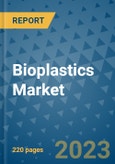Addressing the escalating environmental impact of plastics and the need for sustainable waste management worldwide, bioplastics continue to emerge as a viable alternative. With the world generating over 200 million tons of plastic waste annually, of which less than 10% is recycled, there is a critical demand for effective sustainable alternatives to conventional plastics.
Introduction of New Biopolymer Varieties to Drive Bioplastic Sales
Although bioplastics currently account for just over 1% of global plastics production, the market is experiencing progressive growth. Production volumes have doubled over the past decade, and demand is rising due to the increasing sophistication of bioplastics and the introduction of new variants in biopolymer categories. Biopolymer varieties such as bio-based polypropylene (PP), polylactic acid (PLA), and polyhydroxyalkanoates (PHAs) are experiencing high demand. With the introduction of new products and exploration of new application areas, the bioplastics market is poised for further growth in the near future.
Automotive and Packaging Industries Drive Bioplastics Consumption
The automotive industry, driven by the rise of e-mobility, is undergoing material innovation. Bioplastics are increasingly preferred for various automotive components, driven by the demand for lightweight and energy-efficient automobiles. In addition to interior applications, automakers are utilizing bioplastics for under-the-hood and exterior applications to reduce reliance on volatile energy markets.
The packaging industry is a major consumer of bioplastics, particularly as it transitions from a linear to a circular economy. New bioplastic variants, such as polyethylene furanoate (PEF), are expected to enter the market with superior thermal and barrier attributes. Furthermore, the expanding application base in areas such as wound management, drug delivery, tissue engineering, and orthopedic devices is driving demand for bioplastics in the global market. The medical industry is increasingly considering bioplastics as an ideal material for numerous applications.
Asia Pacific Leads Global Bioplastics Production
Europe is expected to be at the forefront of bioplastics consumption, as the region pioneers the path to a sustainable and circular bio-economy. North America will also be a significant market for bioplastics manufacturers. In Asia Pacific, the expansion of the flexible packaging sector particularly benefits bioplastics companies. Production-wise, Asia Pacific contributes nearly 50% to the global bioplastics market.
Competition Landscape in the Global Bioplastics Market
Leading players driving competition in the global bioplastics market include Eastman Chemical Company, Dow Inc., Novamont S.p.A., BASF SE, Plantic, Corbion N.V., Natureworks, Mitsubishi Chemical Holdings, Biome Technologies plc, and Danimer Scientific. Eastman Chemical Company recently introduced Trēva™, a cellulose-based bioplastic variant that has the potential to replace conventional engineering polymers. The surge in sales of single-use/disposable plastics during the COVID-19 pandemic poses a setback for bioplastics and biodegradable plastics manufacturers, as well as ongoing waste management initiatives.
Table of Contents
Companies Mentioned
- BASF SE
- TotalEnergies Corbion
- Mitsubishi Chemical
- Eastman
- NatureWorks LLC
- Covation Biomaterials
- Avantium
- Kaneka Corporation
- Futamura
- Jinhui Zhaolong High Tech.
- Zhejiang Hisun Biomaterials
- Bio Valore World SpA
- ANKOR Bioplastics
- Celanese Corporation
Methodology

LOADING...








